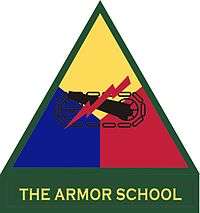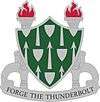United States Army Armor School
The United States Army Armor School is a training school located at Fort Benning, Georgia. Its primary focus is the training of United States Army soldiers, NCOs, and commissioned officers in the operation, tactics, and maintenance of Armor forces and equipment, including the M1 Abrams main battle tank, the Bradley Fighting Vehicle, assorted crew-served and personal weapons, and various other equipment including radios. The school is also the site where U.S. Marines are sent for training on the Abrams tank. The Armor School moved to Fort Benning in 2010 as part of the United States' BRAC program.
History
The United States Army Armor School was established on 1 October 1940, in Fort Knox, Kentucky as the Armored Force School.[2] 80,000 students passed through the school in its first four years, with the first class starting 4 November of the same year.[2] As of 30 September 1965, the armor school had graduated 214,122 students – 59,737 of which were officers, 140,909 of which were enlisted soldiers, 13,476 of which were officer candidates – as well as students from 63 nations.[3]
The school was established by then-Lieutenant Colonel Stephen G. Henry under the guidance of Brigadier General Adna R. Chaffee, for whom the headquarters building is now named after. On 1 July 1957, the school was given its current name.[3] It originally consisted of seven departments: Tank, Wheeled vehicle, Motorcycle, Communication, Tactics, Gunnery, and Field engineering.[3]
Courses offered
Armor Basic Officer Leaders Course
The Armor Basic Officer Leaders Course (ABOLC) is the introductory skills course for United States Army Cavalry and Armor Second and First Lieutenants.[4] These officers, recent graduates of the United States Military Academy, ROTC programs, and Officer Candidate School, receive eighteen weeks of training in basic soldiering skills, maneuver tactics, troop- and company-level strategy, and logistical planning.
Students must complete, among many tasks, four main field training exercises. The first five-day exercise covers cavalry operations, the second covers heavy armor operations, and the third covers contemporary operating environment (COE) operations.[4] The final exercise, known as "the Gauntlet," is a strenuous ten-day movement which covers all subjects in the first three operations. Students are evaluated based on their performance during each exercise, and rotate among every position within a platoon and troop.
The course is instructed by officers, non-commissioned officers, and civilians from the 2nd Squadron, 16th Cavalry Regiment of the 199th Infantry Brigade.
Armor Master Gunner Course
The Armor Master Gunner Course is a strenuous fifty-five-day course offered by the United States Army Armor School.[5] Twenty-five days of the course is hands on activity, while twenty-eight days of the course consist of classroom instruction. Students must complete six exams and all hands on exams with 100% accuracy.
The course is the most focused of the courses offered at the Armor School, with eighteen students per class and a 2 to 1 student to teacher ratio. The course instructs on the M1A1 Tank and M1A2 SEP Tank.
The course is instructed by officers and non-commissioned officers from the 3rd Squadron, 16th Cavalry Regiment of the 316th Cavalry Brigade.
To be eligible to attend, a student meet some of the following criteria:[6]
- Be a member of the United States Army or United States Marine Corps.
- Be between the grade of E-5 (Sergeant) and E-7 (Sergeant First Class/Gunnery Sergeant).
- Have a Military Occupational Specialty code of 19K (Armor Crewmen).
- Volunteer for the course.
- Have at least ten months remaining in their contract to the United States Army
Army Reconnaissance Course
The Army Reconnaissance Course (ARC) is a twenty-seven-day course offered by the United States Army Armor School.[7] Instruction centers on mounted and dismounted reconnaissance for small- to mid-level units, as well as advanced technological techniques such as UAV deployment, air-ground integration, and advance navigation. The course is taught predominantly around practical exercises, with four days of classroom instruction, four days of simulator training, six days of squad-level exercises, and eleven days of platoon-level exercises.[7]
Originally known as the Scout Platoon Leaders Course, it was created in 1986 to instruct junior officers in reconnaissance techniques. The outcomes of the course were successfully noticed in Operation Desert Storm, and the course was opened to other MOSs in 1995. It was renamed the Scout Leaders Course in 2002 after being opened to both officers and non-commissioned officers, and then again to its present name. It has been modified to handle up to 1,200 students per year beginning in 2011.[7]
The course is instructed by officers and non-commissioned officers from the 3rd Squadron, 16th Cavalry Regiment of the 316th Cavalry Brigade.
To be eligible to attend, a student must meet the following criteria:[8]
- Be a member of the United States Army or United States Marine Corps.
- Be of the appropriate rank:
- For officers, between the rank of Second Lieutenant and Captain.
- For non-commissioned officers, above the grade of E-5 (Sergeant).
- Have a military occupational specialty code in one of the following areas: Armor, Infantry, Engineer, Aviation, Military Intelligence, or Field Artillery, or be servicemembers attached to reconnaissance elements within the Signal Corps, Military Police Corps, or Chemical Corps.
- Have graduated either the Basic Officer Leaders Course (officers) or Basic NCO course (non-commissioned officers).
The top twenty percent of the class are added as members of the Commandant's List, and one student selected by their peers receives the J.W. Thurman Award.
Cavalry Leader Course
The Cavalry Leaders Course (CLC) is a fifteen-day reconnaissance and security operations focused course offered by the United States Army Armor School.[9] This mastery level course in reconnaissance and security operations emphasizes planning and decision making at the Squadron to Troop level through the Rapid Decision Making and Synchronization Process (RDSP), Troop Leading Procedures, and tactics for mid-level to senior members of the United States Army and United States Marine Corps. To successfully complete the course, students must pass three competitive practical exercises requiring a demonstrated ability to plan, prepare and conduct simulated reconnaissance and security operations at the Squadron and Troop level.[9]
The course is instructed by officers and non-commissioned officers from the 3rd Squadron, 16th Cavalry Regiment of the 316th Cavalry Brigade.
To be eligible to attend, a student meet the following criteria:[8]
- Be a member of the United States Army or United States Marine Corps.
- Be of eligible rank:
- For officers, between the rank of First Lieutenant (Promotable) and Lieutenant Colonel.
- For non-commissioned officers, above the rate of E-8 (Master Sergeant/First Sergeant).
- Have a Military Occupational Specialty code in one of the following areas: Armor, Infantry, Engineer, Aviation, Military Intelligence, Field Artillery, or Signal Corps.
- Have orders stating that they will be planners, commanders, Troop First Sergeants, Squadron Operations Sergeants, or Operations Sergeants Major of a United States Cavalry unit.
- Have graduated either the Captains Career Course (officers) or Battle Staff NCO course (non-commissioned officers).
- Possess a SECRET military security clearance.
Instructors
Instructors for the United States Army Armor School are soldiers of the 316th Cavalry Brigade. Instructor certification is a strenuous process, with non-commissioned officers being pre-screened through the Army Basic Instructor Course.
After qualifying through the course, they must then be certified through the United States Army Armor School and the 316th Cavalry Brigade in a two-week course which centers on appropriate techniques of instruction and tactics.[10]
Upon being both qualified and certified, instructors are authorized to wear the Fort Knox instructor badge, similar to the Armor School Distinguished Uniform Insignia. It is worn in the same position as the Recruiter Badge.[10]
International students
The United States Army Armor School educates military officers from foreign countries in its programs as well. Due to the recent separation of the Maneuver Captains Career Course, the majority of international students attend the Armor Basic Officer Leaders Course, with an average of four students per class. Student come from (in order of number who attend) Jordan, Lebanon, Saudi Arabia, Egypt, Greece, and the Republic of Turkey. A majority of Egyptians attend the course to train on their recently acquired M1 Abrams.
See also
References
- ↑
- 1 2 3 ARMOR SCHOOL MARKS 25th YEAR OF SERVICE. Armor Magazine, November–December 1965, p. 32-33, Vol: LXXIV, No: 6.
- 1 2 "316th Cavalry Brigade", http://www.knox.army.mil/school/16cav/bolc_intro.asp The United States Army. 20 August 2010. Retrieved 20 October 2010.
- ↑ "316th Cavalry Brigade", http://www.knox.army.mil/school/16cav/MG1.asp The United States Army. 20 August 2010. Retrieved 20 October 2010.
- ↑ "316th Cavalry Brigade", http://www.knox.army.mil/school/16cav/MG4.asp The United States Army. 20 August 2010. Retrieved 20 October 2010.
- 1 2 3 "316th Cavalry Brigade", https://www.us.army.mil/suite/doc/19067813 The United States Army. 20 August 2010. Retrieved 20 October 2010.
- 1 2 "316th Cavalry Brigade", http://www.knox.army.mil/school/16cav/CLC6.asp The United States Army. 20 August 2010. Retrieved 20 October 2010.
- 1 2 "316th Cavalry Brigade", http://www.knox.army.mil/school/16cav/CLC2.asp The United States Army. 20 August 2010. Retrieved 20 October 2010.
- 1 2 "316th Cavalry Brigade", http://www.knox.army.mil/school/16cav/default.asp The United States Army. 20 August 2010. Retrieved 4 October 2010.
External links
- website
- http://www.army.mil/-news/2010/05/25/39763-chiarelli-armor-school-moving-home-to-benning/
- http://www.army.mil/-news/2011/01/19/50548-armor-school-kicks-off-first-class-at-harmony-church/


